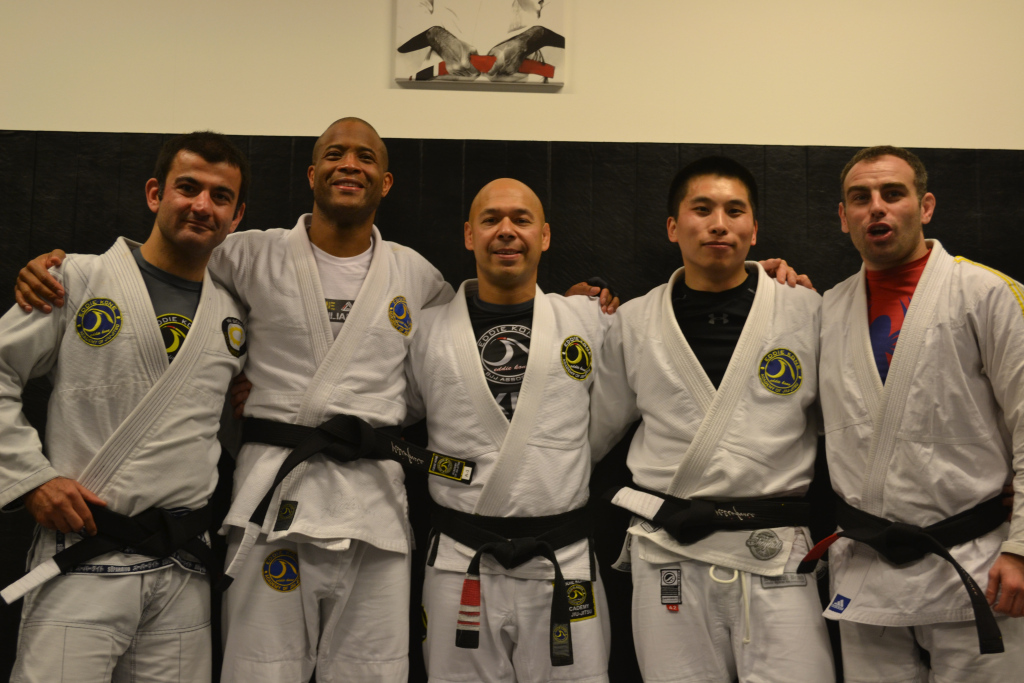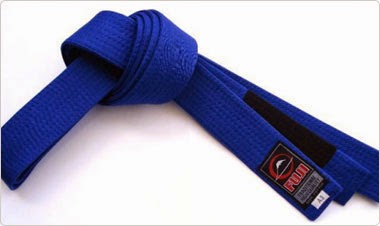In order to get a blue belt in Brazilian Jiujitsu, you need to show your instructor that you have embraced the fight ideology of jiujitsu (close the distance, take down / pull guard, climb the positional hierarchy, finish the fight) and demonstrate that ideology by leaving your strength and speed at the door and embodying the fundamentals and basics of jiujitsu.
Fundamentals of Jiujitsu:
The fundamentals are, in my opinion, not jiujitsu techniques per se but rather the solo movements that build jiujitsu and, consequently, all healthy movement. These movements are performed in a very similar fashion by all jiujitsu practitioners and other grapplers irrespective of belt and level.Bridging (3 variations)
Shrimping (3 variations)
Getting to your knees from lying flat on your back (2 variations)
Squatting
Lunges
Rolling over your shoulder (3 variations)
Breakfalls
Pivoting over your knee
Hip switching / Box drill
Sprawling
Standing up from lying flat on your back (Technical Stand-up)
Generating momentum on your feet (6 directions)
Generating momentum on the ground (2 variations)
While two jiujitsu black belts may show you two slightly different methods to perform an arm lock from guard or how to set up the triangle choke from side control top, 99% of grapplers and jiujitsu practitioners will perform the above fundamentals the same way. This, to me, is the true heart of jiujitsu. Not the medals, not the self defence, but learning how to move correctly.
Basics of Jiujitsu:
The basics are what we recognize more as jiujitsu and or grappling techniques.Since jiujitsu can be seen to include 1000s of techniques, how do we decide what makes the cut for this list of basics? I use the following principles:
1. Techniques that occur the most often during self defence and grappling with or without the gi.
2. Techniques that use natural body motions or, as mentioned above, the fundamentals of movement and do not necessarily require extraordinary attributes such as speed, strength or flexibility.
3. Techniques that build solid grappling and jiujitsu habits such as keeping your elbows close, weakening the opponent's position before attacking, using leverage to enter or escape a position...etc.
4. Techniques that gel well with each other to create a solid grappling game.
Beyond understanding the positions themselves and how to maintain / escape them (which is art onto itself), here's a short* but rather comprehensive list of jiujitsu techniques that you should know well before expecting to reach the rank of blue belt in jiujitsu:
Mount top: Cross choke, Americana, Spinning armbar, back take
Mount Bottom: Upa (3 variations), elbow knee escape (3 variations)
Back offence: Rear Naked Choke (3 variations), re-mount, sliding collar choke
Back defence: Weak side escape, strong side escape, slide down escape
Side control offence: Progress to mount (2 variations), americana shoulder lock, Kimura shoulder lock, bread cutter choke, spinning arm lock.
Side control defence: Guard recovery, get to knees and double leg takedown / tackle, technical bridge and roll
Guard offence: Cross choke (2 variations), spinning armbar, Kimura, trinagle choke, scissor & push sweeps, technical stand up, back take from the guard
Guard defence: Guard opening by standing, double under stack pass, staple (shin across thigh) guard pass (2 variations), Toreada pass, knee slide pass
Half guard offence: Recover guard, take the back, old school sweep and pass to side control, plan B sweep and pass to side control
Half guard defence: pummeling for the underhook, Escrima pass (far side underhook), reverse escrima pass (nearside underhool), Turn to face the leg and pass (underhooking the leg), straight arm lock (against their underhook)
Stand up offence: offensive grip fighting, leg hook takedown, body lock takedown, double leg takedown, single leg takedown, back take, rear takedown, hip throw, pull guard
Stand up defence: sprawl, break grips, pummel, free the leg from the single leg, safe clinching against strikes
*Not all academies and BJJ gyms will have the same curriculum. Some will have less techniques (ommitting any focus on strike-efficiency...etc.) while others will have an extensive stand-up self defence curriculum to test on. In fact, many jiujitsu schools don't even have a curriculum which I personally find very disappointing.
Below you can see Rickson & Helio Gracie student, coral belt master Pedro Sauer show his blue belt curriculum:
Part 1:
Part 2:
Further, here are some very deep thoughts on the belt progression within Brazilian jiujitsu by people far cleverer than I am:
Roger Gracie black belt and founder of the Jiujitsu Brotherhood Nic Gregoriades.
Matt Kirtley, founder of Aesopian BJJ, and his curriculum to BJJ Blue Belt.
One of the Dirty Dozen on BJJ and founder of Harris International, Roy Harris.
--------------------------------------------------
ZHOO ZHITSU IS FOR EVERYONE!


No comments:
Post a Comment